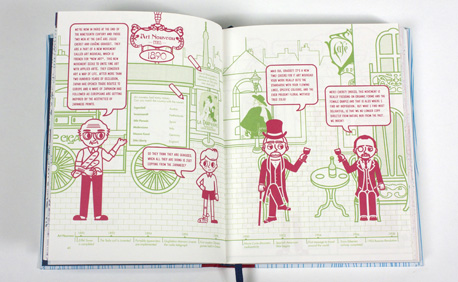A History of Graphic Design for Rainy Days
Who can resist a book that provides a paper doll of Saul Bass?
Jam-packed, whirlwind, and charming are the three best words to describe_ A History of Graphic Design for Rainy Days_ from Gestalten Press. On a rainy afternoon “somewhere in some country” the reader is introduced to the two main characters, Gramps and Kiddo. The young bored Kiddo ventures into the office of his Gramps, who is working on a letterpress machine.
Kiddo asks the simple question, “What in the world is graphic design?”
To answer the question, Gramps takes the curious Kiddo on an illustrated journey through time to learn the history of graphic design. Designed by Studio 3, the book is an inviting graphic novel that is easy to pick up and immediately start reading. It is also very ambitious.
Beginning at the dawn of the Industrial Revolution in 1776 and traveling through time to the Digital Revolution of the 1990s Gramps and Kiddo make an appearance on every spread as they jump from historical events like Art Nouveau, Polish Poster Designs, and Postmodernism. The reader will find Kiddo holding a conversation in the men’s bathroom with Jan Tschichold and later see him stumble into a bar as Aleksander Rodchenko throws one back with his Russian Constructivist buddies. There is also something delightful about watching Gramps grill a burger in an IBM apron as Paul Rand suns himself in a nearby lounge chair.
However, do not let the humor undercut the historical and intellectual merits of the book.
In Bauhaus, the information is spread through several pages using text-heavy talk bubbles and displaying diagrams like the Bauhaus course wheel and Johannes Itten’s Farbkreis color wheel. There are even small timelines that mark current events like when the BBC was founded or when the Great Depression began.
Building on their experience from Hyperactivity Typography from A to Z, Studio 3 infuses every inch of _A History of Graphic Design for Rainy Days _with informative texts about leaders of design, seminal works and important technologies.
Each spread uses two colors with famous design pieces reworked as one-color illustrations. Cartoons of important design figures like Paul Rand and Jessica Helfand pop up throughout the book. This graphic stylization allows for visual consistency while maintaining the iconic integrity of each piece and person.
The book introduces historical genres at every turn. Readers learn the conventions of Art Nouveau as Eugene Grasset sits and cheers his fellow designer outside a Paris Café,
“Merci, Cheret! Indeed, this movement is really focusing on organic forms and the female shapes and that is also where I find my inspiration. But what I find most delightful is that we no longer copy directly from nature nor from the past. We invent!”
Even the influence of graphic design in outer space is covered.
_“Did you know that the first typeface to ever walk the moon was Futura? NASA used it on the commemorative plaque for Apollo 11 which they left on that big piece of rock in 1969.” _
The book is peppered with activities and timelines for topics like the Bauhaus, Penguin Books and Punk Design. There are fill-in-the blank exercises, crossword puzzles and even a color-your-own Rietveld Red, Blue Chair in the Bauhaus section. While these activities are engaging and fun, they can be difficult to answer correctly if the reader is not familiar with graphic design history.
Coming to the book as a relative novice to the topic, I was stumped by a fill-in-the-blank asking for the names of the design duo that created Émigré magazine. (Rudy VanderLans and Zuzana Licko) I flipped to the back of the book hoping to find an answer key. No luck. It was frustrating not to have answers to reference. A credit page states that the answers are posted online at graphicdesignforrainydays.com but unfortunately, at the time of publishing this review, there was no answer key on the book’s website.
However, I did find a nice surprise at the back of the book. Here, a series of paper pieces beg to be cut out. Readers can trim and display a First Things First Manifesto or construct a Macintosh computer circa 1990. Or, they may simply play with the paper dolls of Josef Müller-Brockmann and Henri de Toulouse-Lautrec.
For those new to graphic design history, the book is an easy introduction to important people and ideas. Experienced history buffs will be entertained by the graphic translation of serious genres, and even get to test their knowledge on the various quizzes and interactive elements. The strength and charm of the book lies in its illustration style and humorous narrative of the history of graphic design.
And also, that paper doll of Saul Bass.
**Publisher Information **_Graphic Design History for Rainy Days _is set to release in the US, November 2011 through Gestaltan Press. You can support the Designer’s Review of Books by ordering from Amazon (US | CA | UK | DE )
**About the Reviewer **Ann Liu Alcasabas is graphic designer, educator and devout coffee drinker. She is currently freelancing and teaching graphic design in Baltimore at the Maryland Institute College of Art. You can follow her @annmaryliu, and find her work online at annmaryliu.com.







